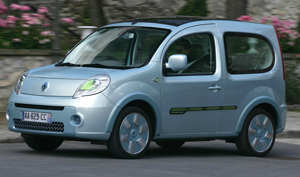
PARIS – Renault SA has produced a prototype of its coming electric utility vehicle to begin communicating more forcefully on its electric-vehicle strategy.
A single version of the Kangoo BeBop Z.E., painted light blue, will undergo test drives by 15 European journalists each day during July.
The prototype is much more realistic than the concept car unveiled at the Paris auto show last fall, but it still is only a hint of the Kangoo to come to market in 2011.
The prototype’s 551-lb. (250-kg) lithium-ion battery will give it a range of only 62 miles (100 km), while the production Kangoo is expected to have a 100-mile (160-km) range.
In addition, the real vehicle will have a new recharging plug being developed by a consortium of 20 companies in Europe in an effort to achieve standardization. That 3-phase plug can be used with a 400-volt power supply to enable a complete battery charge in about 20 minutes. The prototype uses a fast-charge plug that allows an 80% recharge in 30 minutes.
All production Renault EVs also will be rechargeable with regular 240-volt European household current, with a 10-amp service providing a full charge in eight hours, and a 16-amp service recharging in six hours.

The Kangoo and a version of the Renault Megane midsize sedan will be the first Renault EVs in 2011. The 4-door Megane will be released first in Israel, as part of the Better Place project. It then will be launched in Europe, where it will be followed by the Kangoo BeBop Z.E.
Later in 2011, a purpose-built Renault city car will be launched, and in 2012 an electric compact hatchback will appear.
Meanwhile, Renault’s alliance partner, Nissan Motor Co. Ltd., is developing EVs using the same critical components.
Nissan plans to launch its first EV in Japan in September 2010 and in Europe in early 2011.
Some of the EVs of each company will use the battery-exchange principal demanded by Better Place. At Renault, the Kangoo will not have that feature, but the Megane will.
If dealerships or service stations can exchange a near-empty battery for a full one in several minutes, the operation will be as fast as filling a fuel tank.
All Renault and Nissan EVs will have standard navigation systems capable of indicating where the nearest battery-exchange or recharging station is located.
Renault is expected to unveil its first three EVs at the Frankfurt auto show in September, and Nissan is likely to have one or more vehicles at the Tokyo show in October.



